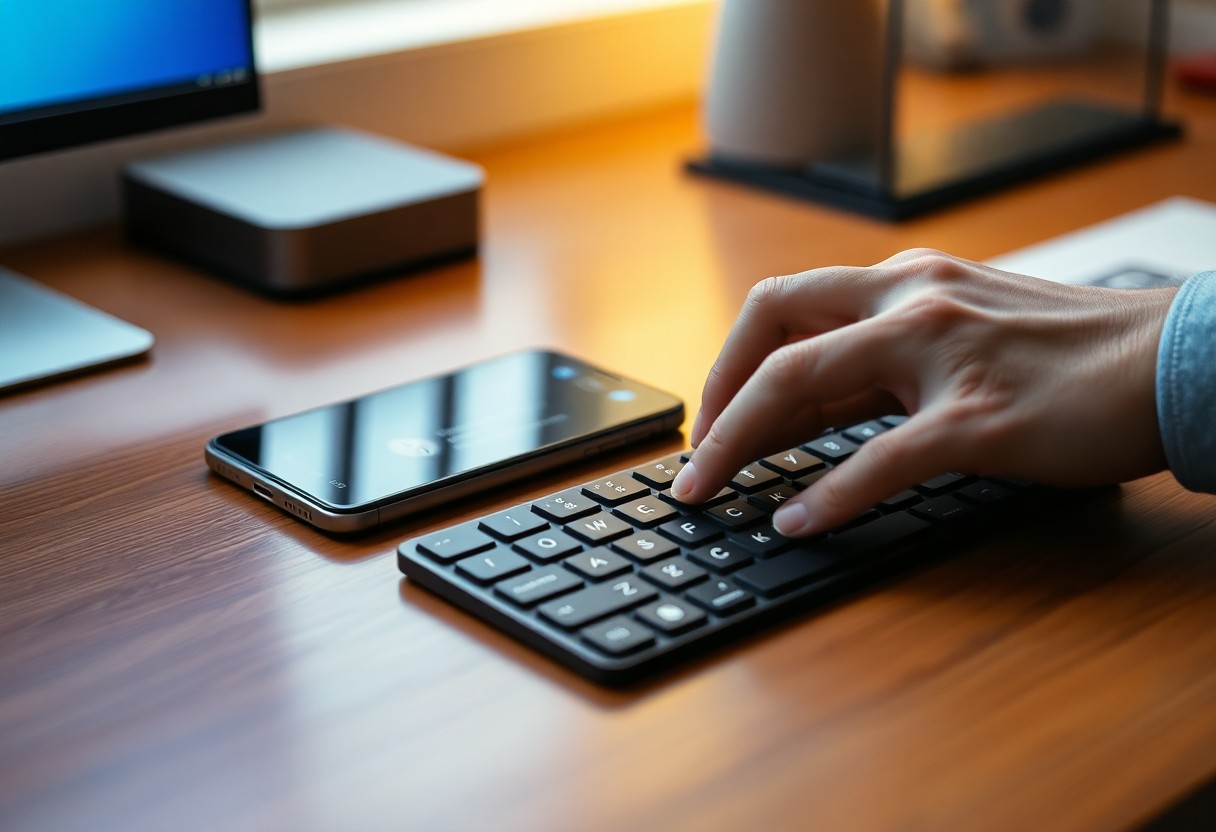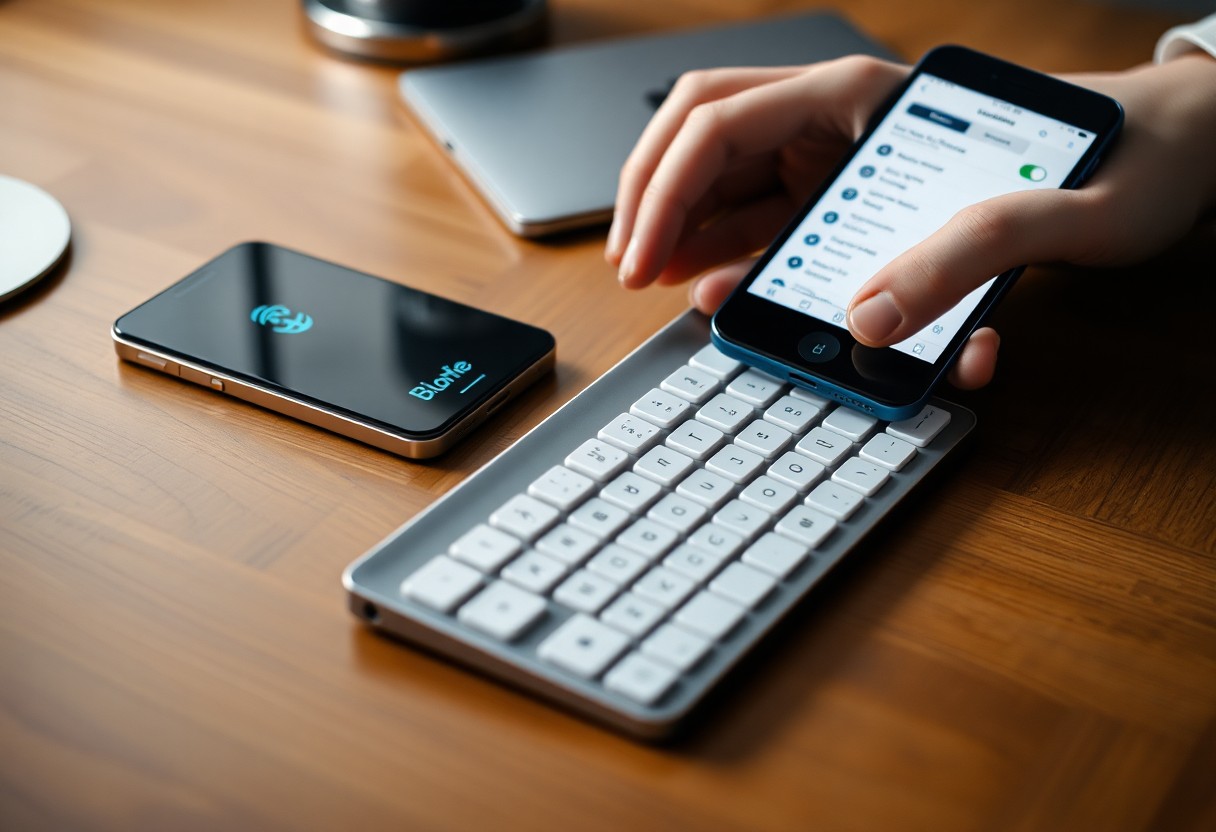Many users find that connecting a keyboard to their mobile device can significantly enhance productivity and ease of use. In this guide, you will learn how to connect your keyboard—whether it’s via Bluetooth or USB—to your mobile device seamlessly. Improper connections can lead to device malfunctions, so it’s necessary to follow the steps carefully. You’ll also discover the advantages of using a keyboard, such as faster typing speeds and improved multi-tasking capabilities, which can transform how you interact with your mobile device.
Table of Contents
Key Takeaways:
- Compatibility: Ensure your keyboard is compatible with your mobile device, whether it’s Bluetooth or USB-C.
- Pairing Process: Follow the correct pairing process for Bluetooth keyboards by enabling Bluetooth on your mobile and searching for devices.
- Software Settings: Adjust the settings on your mobile device if necessary, enabling specific keyboard features or layouts.

Understanding Your Mobile Device
A thorough understanding of your mobile device is vital when connecting a keyboard. This knowledge helps you navigate compatibility issues and operating system features that may affect the connection process. By familiarizing yourself with your device’s specifications and settings, you can make the keyboard setup smooth and efficient. This will ultimately enhance your typing experience while using your mobile device.
Compatibility Check
Check if your keyboard is compatible with your mobile device. Most modern keyboards connect via Bluetooth or USB, but not all devices support every keyboard type. Ensure that your mobile device supports the connection method your keyboard uses. This compatibility ensures seamless functionality.
Operating System Considerations
Your mobile device’s operating system can impact the keyboard connection process. Different operating systems may have varying levels of support for external keyboards, affecting how you interact with apps and text inputs.
Considerations like software updates can enhance your keyboard’s functionality. Keeping your operating system updated ensures you enjoy the latest features and security patches. Also, understand that iOS devices often offer better compatibility with third-party keyboards compared to Android devices, which may require additional settings adjustments. Check your device’s manufacturer guidelines for the best connection practices, as this can significantly affect your experience.
Types of Keyboards
Even with the wide range of keyboard options available, you can choose the one that best suits your mobile needs. Here are some of the most common types:
- Wired Keyboards
- Wireless Keyboards
- Bluetooth Keyboards
- Folding Keyboards
- Gaming Keyboards
Assume that you want to optimize your typing experience by selecting a keyboard that fits your specific requirements.
| Type | Details |
| Wired Keyboards | Connects via USB or similar connection |
| Wireless Keyboards | Operates without a physical cable |
| Bluetooth Keyboards | Uses Bluetooth technology for connection |
| Folding Keyboards | Compact and portable options |
| Gaming Keyboards | Designed with gamers in mind, often with customizable features |
Wired Keyboards
If you prefer a direct connection, wired keyboards are a reliable choice for connecting to your mobile device. They typically offer a stable and consistent connection, ensuring that your input is accurately registered without delay. Most wired keyboards connect through USB, making them easy to set up and operate.
Wireless Keyboards
Assuming you desire more flexibility, wireless keyboards allow you to type without being tethered to your mobile device. They often use either Bluetooth or a USB receiver, offering the freedom to move around. Many models are lightweight and portable, making them ideal for on-the-go scenarios.
To enhance your user experience, opt for high-quality wireless keyboards that provide long battery life and a comfortable typing experience. Keep in mind that some wireless keyboards may slightly lag, particularly in less optimal environments. Nevertheless, they offer unparalleled convenience, especially if you travel frequently or work remotely.
How to Connect a Wired Keyboard
Now, connecting a wired keyboard to your mobile device is quite straightforward. If your mobile device supports it, simply plug the keyboard directly into your device’s USB port using an adapter, and you’ll be ready to type. Keep in mind that not all devices support this feature, so always check your device specifications before proceeding.
Using USB OTG Adapter
Any standard USB OTG (On-The-Go) adapter can turn your mobile device into a more versatile workstation by allowing you to connect your wired keyboard. Simply plug one end of the adapter into your mobile device and the other end into the keyboard’s USB connector. This method usually requires no additional settings and provides a seamless typing experience.
Settings Adjustments
Settings on your mobile device may need to be adjusted for full keyboard functionality.
Using the keyboard can sometimes alter how your device interacts with certain apps, especially when it comes to shortcuts and key mappings. You may find it beneficial to look into your device’s settings menu, where you can customize key functions or change the language layout according to your preference. This adjustment can enhance your overall typing experience and ensure you’re able to utilize all keyboard features effectively, enriching your productivity.
How to Connect a Wireless Keyboard
Despite the convenience of typing on your mobile device’s touchscreen, connecting a wireless keyboard can greatly enhance your productivity. By linking a keyboard to your mobile, you can enjoy quicker typing and improved comfort for extended use, making it easier to tackle emails, documents, and more. Whether you opt for Bluetooth or a USB receiver, the steps to connect a wireless keyboard are straightforward and user-friendly.
Bluetooth Pairing Process
Connect your wireless keyboard to your mobile device by enabling Bluetooth in your device’s settings. Once Bluetooth is turned on, put your keyboard in pairing mode, which usually involves pressing a specific button or combination of buttons. After a moment, you should see your keyboard listed in the available devices on your mobile. Select it to complete the pairing process, and you’re ready to start typing!
Troubleshooting Connection Issues
Assuming you have followed the pairing instructions and your keyboard still won’t connect, you may need to troubleshoot the connection. Ensure that your keyboard has sufficient battery power and is within range of your mobile device. Additionally, confirm that Bluetooth is enabled and not blocked by any previous connections. If all else fails, restarting both your keyboard and mobile device may help resolve the issue.
Pairing and connecting your wireless keyboard should be a straightforward process. However, if you encounter difficulties, ensure your keyboard is charged and in range. Sometimes, outdated software on your mobile can prevent connection, so check for updates as well. If you’re still facing problems, try disconnecting any other Bluetooth devices to reduce interference. By following these steps, you can enhance your chances of establishing a solid connection.
Tips for Optimal Usage
For the best experience while using your keyboard with a mobile device, consider these tips:
- Ensure your device supports external keyboards.
- Keep your keyboard firmware updated for optimal performance.
- Configure your keyboard layout to match your preferences.
- Utilize shortcuts to enhance your productivity.
Any adjustments you make can significantly improve your overall experience.
Key Mapping and Customization
While customizing your keyboard’s key mapping, you can better tailor it to your personal needs. Many mobile operating systems allow you to assign specific functions or apps to different keys. This personalization can streamline your workflow and make typing more efficient. Explore the settings on your device for mapping options.
Enhancing Typing Experience
Mapping additional features to function keys can substantially increase your typing efficiency.
Plus, by integrating custom shortcuts and utilizing features like auto-correct and predictions, your typing experience can transform into a much quicker and more enjoyable process. Adjust settings such as keyboard sensitivity to suit your style and ensure a comfortable grip during long typing sessions. Make sure to choose a layout that feels natural for your hands, as this will help you avoid fatigue. Prioritize these optimizations for a smoother interaction with your mobile device.

Factors to Consider
Once again, when connecting a keyboard to your mobile, you should evaluate several important aspects. Consider the following:
- Compatibility with your device
- Connection type (Bluetooth or USB)
- Size and portability
- Battery life and maintenance needs
Any of these factors can enhance or hinder your overall experience with a keyboard on your mobile device.
Keyboard Size and Portability
One key aspect to consider is the size and portability of the keyboard. Depending on your lifestyle, you may prefer a compact keyboard that is easy to carry in a bag or pocket. Ensure that it fits your needs, whether you are working on the go or using it at home.
Battery Life and Maintenance
To maximize your keyboard’s performance, you need to pay attention to battery life and maintenance. Low battery levels can lead to interruptions while you are typing, so choosing a keyboard with a long-lasting battery is advisable.
Understanding the battery life of your keyboard is necessary for seamless usage. Look for models that have an extended battery lifespan and consider how often you’ll need to replace or charge it. Regular maintenance, such as cleaning the keys and ensuring the connectivity port is free of debris, can also contribute to the longevity and optimal performance of your keyboard. A well-maintained keyboard can provide a reliable typing experience regardless of your mobile device.
To wrap up
Considering all points, connecting your keyboard to a mobile device can greatly enhance your typing experience. Start by ensuring your mobile supports Bluetooth or has an OTG feature for wired keyboards. By following the appropriate steps, you can enjoy the convenience of a larger input device. If you are looking for alternative methods, check out this link on how to connect a wired keyboard to my mobile without an … for more insights.
Q: What types of keyboards can I connect to my mobile device?
A: You can connect various types of keyboards to your mobile device, including wired USB keyboards, wireless Bluetooth keyboards, and even mobile-specific keyboards designed for touch screens. Most mobile devices are compatible with Bluetooth keyboards, while some may require an OTG (On-The-Go) adapter to connect a USB keyboard.
Q: How do I connect a Bluetooth keyboard to my mobile device?
A: To connect a Bluetooth keyboard, first ensure that your keyboard is charged and in pairing mode. On your mobile device, go to the Bluetooth settings and turn on Bluetooth. Your mobile device will scan for available devices. Select your keyboard from the list, and if prompted, enter the pairing code displayed or provided by the keyboard. Once successfully paired, you can start using your keyboard immediately.
Q: What do I need to use a wired keyboard with my mobile device?
A: To use a wired keyboard with your mobile device, you’ll typically need an OTG adapter if your device supports USB OTG. Connect the keyboard’s USB plug into the OTG adapter, then plug the other end of the adapter into your mobile device’s charging port. Your device should automatically recognize the keyboard, enabling you to start typing right away.